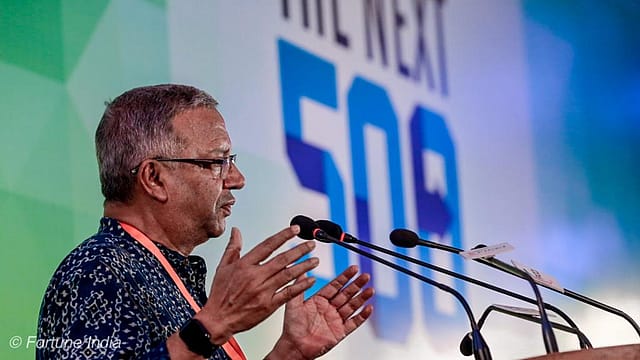The economic well-being of the country has dramatically changed: Samit Ghosh
ADVERTISEMENT

In May this year when tropical Cyclone Fani hit the state of Odisha severely damaging its coastal districts including the temple town of Puri, the team at Ujjivan Small Finance Bank were prepared to provide basic banking services during and in the aftermath of the cyclone.
“We have about eleven branches in and around Puri. We realised that one of the key services which is required when a natural calamity like that hits an area is people need cash,” said Samit Ghosh, CEO and managing director, Ujjivan Small Finance Bank at the fifth edition of the Fortune India Next 500 summit in New Delhi on Friday evening.
Addressing a gathering of top executives from the country’s largest midsize companies and policymakers, Ghosh said, “During such calamity electricity and Internet goes down. It was imperative for us to be there well in advance with our engineers to get our ATMs (automated teller machines) up. We are less than a two-year-old bank but we were there to serve the public.”
As soon as the cyclone was over, we were one of the first banks which had its ATMs functioning, he said, adding that “Many people told us why we call ourself a Small Finance Bank when we were one of the few banks whose ATMs were working. The name Small Finance Bank is mandated by the Reserve Bank of India mainly to make sure that our focus is on the mass market which is almost 80% of our population.”
January 2026
Netflix, which has been in India for a decade, has successfully struck a balance between high-class premium content and pricing that attracts a range of customers. Find out how the U.S. streaming giant evolved in India, plus an exclusive interview with CEO Ted Sarandos. Also read about the Best Investments for 2026, and how rising growth and easing inflation will come in handy for finance minister Nirmala Sitharaman as she prepares Budget 2026.
Ranked 91 on the Fortune India Next 500 2019 list, Ujjivan Financial Services is one of India’s most successful non-banking finance companies (NBFCs) which in 2017 went on to become a small finance bank. Today it has over 464 branches across 24 states in India.
“Our focus is on the mass market because we believe that it is a segment which provides us the biggest opportunity. The mass market is still either unserved or underserved,” said Ghosh, a former Citibank executive.
According to reports in the last few years, the bottom of the pyramid in India has started moving up. Ghosh points out that the economic well being of the country has dramatically changed. “It is not just because of micro-finance it is also because of various poverty elevation programmes which the government has implemented backed by technology. This change has happened more in the last five years,” he explains.
The Fortune India Next 500 summit is an annual event which celebrates the contribution of midsize companies to the economy. This year the event’s focus was on technological trends and innovations fuelling the growth of midsize companies in India.
Ghosh feels to grow in a highly commoditised banking market it is important to understand the financial needs of the mass market and the level of technological adoption, and develop products accordingly. “We always had the dream that we will set up an institution which can provide service to this segment and a full range of products,” he said.
The Bengaluru-based Small Finance Bank is looking to serve 40 million customers from 4 million at present in next seven years. “The only way we can do it is by effective use of technology and bringing the operating cost down because in a mass market the transaction sizes are small compared to a middle class and affluent banking market,” adds the 69-year-old banker.
Ujjivan has invested heavily into infrastructure, technology, and people. “Today we have new processes, systems and technology in place,” said Ghosh.
